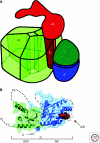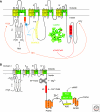Voltage-gated calcium channels
- PMID: 21746798
- PMCID: PMC3140680
- DOI: 10.1101/cshperspect.a003947
Voltage-gated calcium channels
Abstract
Voltage-gated calcium (Ca(2+)) channels are key transducers of membrane potential changes into intracellular Ca(2+) transients that initiate many physiological events. There are ten members of the voltage-gated Ca(2+) channel family in mammals, and they serve distinct roles in cellular signal transduction. The Ca(V)1 subfamily initiates contraction, secretion, regulation of gene expression, integration of synaptic input in neurons, and synaptic transmission at ribbon synapses in specialized sensory cells. The Ca(V)2 subfamily is primarily responsible for initiation of synaptic transmission at fast synapses. The Ca(V)3 subfamily is important for repetitive firing of action potentials in rhythmically firing cells such as cardiac myocytes and thalamic neurons. This article presents the molecular relationships and physiological functions of these Ca(2+) channel proteins and provides information on their molecular, genetic, physiological, and pharmacological properties.
Figures




References
-
- Ahlijanian MK, Westenbroek RE, Catterall WA 1990. Subunit structure and localization of dihydropyridine-sensitive calcium channels in mammalian brain, spinal cord, and retina. Neuron 4: 819–832 - PubMed
-
- Arikkath J, Campbell KP 2003. Auxiliary subunits: Essential components of the voltage-gated calcium channel complex. Curr Opin Neurobiol 13: 298–307 - PubMed
-
- Armstrong CM, Bezanilla FM, Horowicz P 1972. Twitches in the presence of ethylene glycol bis (-aminoethyl ether)-N,N′-tetracetic acid. Biochim Biophys Acta 267: 605–608 - PubMed
-
- Artalejo CR, Adams ME, Fox AP 1994. Three types of calcium channel trigger secretion with different efficacies in chromaffin cells. Nature 367: 72–76 - PubMed
-
- Bajjalieh SM, Scheller RH 1995. The biochemistry of neurotransmitter secretion. J Biol Chem 270: 1971–1974 - PubMed
Publication types
MeSH terms
Substances
Grants and funding
LinkOut - more resources
Full Text Sources
Other Literature Sources
Molecular Biology Databases
Miscellaneous
